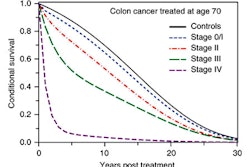NEW YORK CITY - Concern about radiation dose from medical imaging exams makes it imperative that radiologists proactively find ways to keep dose exposure to a minimum -- and healthcare IT can help, according to Dr. James H. Thrall, who spoke on the topic this week at the New York Medical Imaging Informatics Symposium.
Thrall, radiologist-in-chief at Massachusetts General Hospital (MGH) and professor of radiology at Harvard Medical School, described five ways that information technology can be used to reduce dose exposure to patients. At the same time, healthcare IT can help increase patient safety; reduce unnecessary workload for radiologists, technologists, and administrative and support staff; reduce expenditures for inappropriate exams; support better "best practice" radiology; and assist clinical decision-making by referring physicians.
Concerns about radiation dose
"IT applications represent a major opportunity to ensure the proper use of radiation and the documentation of that use," Thrall said, offering his perspective as both the chairman of a large academic radiology department and as the president of the American College of Radiology (ACR). "I've come to the opinion that concern about radiation dose exposure risk on the part of the public, referring physicians, regulators, and legislators represents the No. 1 nonfiscal challenge to the future of radiology. And if physicians do not order studies due to concerns about radiation risk, this also will be a fiscal challenge."
Thrall attributed the furor of the past several years to nationally publicized medical errors and a number of reports, including the National Commission on Radiation Protection's (NCRP) 2006 report on radiation exposure in the U.S. and the 2005 report on the Biologic Effects of Ionizing Radiation (BEIR VII), which studied the atomic bomb casualty victims in Japan.
In BEIR VII, for the first time the BEIR commission unequivocally endorsed a linear no-threshold model for cancer induction, and the NCRP report identified a sevenfold increase in radiation exposure over a 25-year period from medical exam radiation exposure, mostly due to CT, which accounted for 49% of exposure.
Findings from these and other reports have created what Thrall called a "cottage industry" to extrapolate data, often incorrectly, and write about the risk of developing cancer as a result of having radiology exams. The fact that medical exposure to radiation now equals background radiation exposure from the environment has captured the imagination of the media and regulators, who all vocalize that medical exam radiation exposure should be less, he said.
How IT can help
Thrall stated that radiologists need to realize that IT represents more than just management of data. It is a key strategy for managing radiation dose.
Information technology enables radiology facilities to more strictly monitor exam protocols. The radiology department at MGH uses a password-protected protocol database and network connectivity to manage protocol integrity. The medical director of CT, who is a radiologist, is responsible for approving CT protocols. New or modified protocols are installed by the assistant CT manager, where they are accessed through locked-down consoles. No other protocols are allowed.
This enables the department to develop as many subcategories of protocols as are needed, and to use the lowest diagnostically acceptable radiation dose for a patient based on exam type, age, and weight. With respect to pediatric CT, this represents some 30 different subcategories of protocols and radiation dose. With this approach, the MGH radiology department has been able to reduce radiation exposure by more than 95% for some exams, Thrall stated.
"But we can never expect to maintain that performance on a daily basis without an IT approach, because it's not going to happen if you ask people to remember what they are supposed to do for all of this," he said.
In his opinion, more than 90% of errors and adverse events reported by radiology departments throughout the U.S. could have been avoided if an IT-managed protocol governance solution had been implemented. Thrall pointed out that the series of head CT exam overdoses in October 2009 at Cedars-Sinai Medical Center in Los Angeles occurred because functional CT imaging was being performed using a standard head CT protocol. This delivered eight times the amount of radiation.
Only recently did vendors add controls to prevent CT exam radiation overdose, Thrall said. This was because vendors didn't want to be in the business of practicing medicine, and didn't want to dictate to radiologists what protocols should be used.
But this has resulted in the ability for anyone to walk up to a CT console and add a protocol. Locked-down modality consoles, combined with networked IT solutions, make it simple to implement centralized protocol governance.
MGH pioneered the development and utilization of a computerized physician order-entry (CPOE) system with clinical decision support. From the time of its implementation in 2004 through 2007, the number of procedures at MGH has decreased by 25%. Not ordering an inappropriate exam or an exam with a history of very low diagnostic yield value represents a 100% dose reduction to a patient, Thrall pointed out.
The radiology department has tracked behavior trends of individual physicians who order high-cost imaging procedures. Low-volume users have had the least exam reduction over time, but what is impressive to Thrall is that high-volume users, such as oncologists, have significantly reduced their ordering volume. Has this affected patient outcomes? The department hasn't yet determined this.
The system utilizes ACR appropriateness criteria and has the intelligence to also rate the appropriateness of alternative imaging procedures. When a referring physician logs into the system, the first screen that opens is a dashboard, which provides a summary and a list of all exams the referring physician has ordered, along with a list of reports and an indication of whether the physician has read them. When an exam is ordered for a patient, a list of similar exams performed is presented -- the best way to reduce the ordering of duplicate exams.
The system also delivers just-in-time information about why the exam being ordered for the specific symptoms indicated isn't appropriate. If an MRI exam is indicated, for example, a checklist of patient safety issues may be posted, such as whether a patient is claustrophobic or has a pacemaker or other metal in his or her body.
The value of a just-in-time knowledge IT delivery system is that the information it delivers is both accurate and consistent. It provides a learning opportunity for a physician that is delivered automatically within seconds. This is significantly better than a radiology benefits management (RBM) service, which provides an approved/denied response without necessarily giving a clinical explanation. It also is consistent and reproducible, unlike the "1-800" option, where the decision may be determined by the specific RBM handling the request, or the time of day or month.
With the establishment of the ACR's National Radiology Data Registry, radiology departments can now benchmark what they are doing with respect to radiation dose over time against themselves, similar facilities, facilities in the same geographic region, and facilities nationally.
"If you don't have the ability to benchmark, you are an 'n' of one," he said. "You can trend yourself over time, but radiologists don't know the performance of their department against others. If I ask you, 'What is your average dose?' I'm going to say that you can't tell me. If I ask you how the average dose compares from a year ago, you can't tell me. If I ask you to compare what your dose is to what is possible to achieve, you probably don't know that either. How could you know if you aren't part of a registry?"
He described both open-source and proprietary resources available to calculate and automatically extract, anonymize, and transmit radiation doses for CT scans and digital radiography exams to the registry.
Look beyond the assumption that IT only acquires static data. Mobilize it and make it work for radiologists, referring physicians, and patients, Thrall encouraged attendees.



















